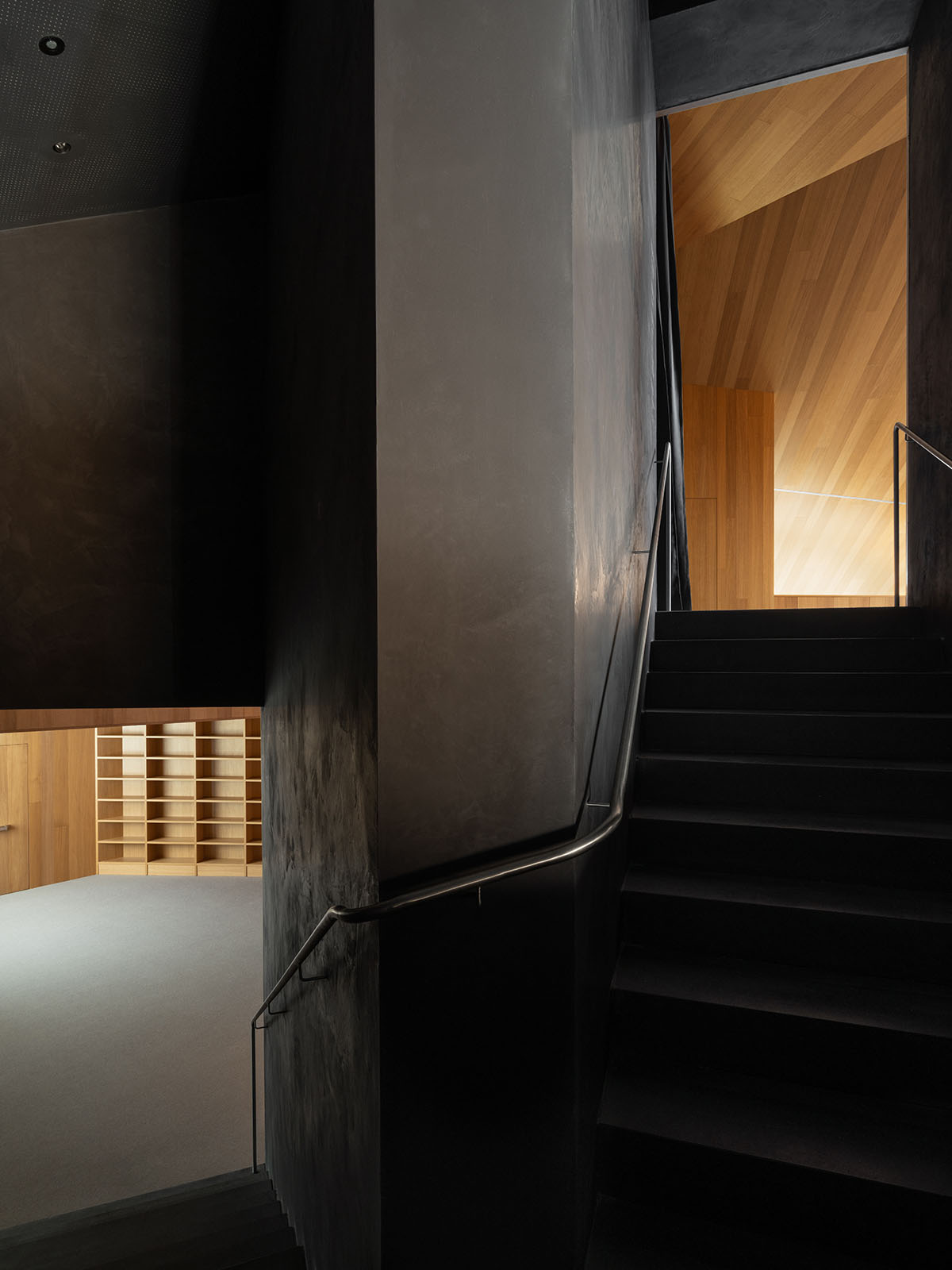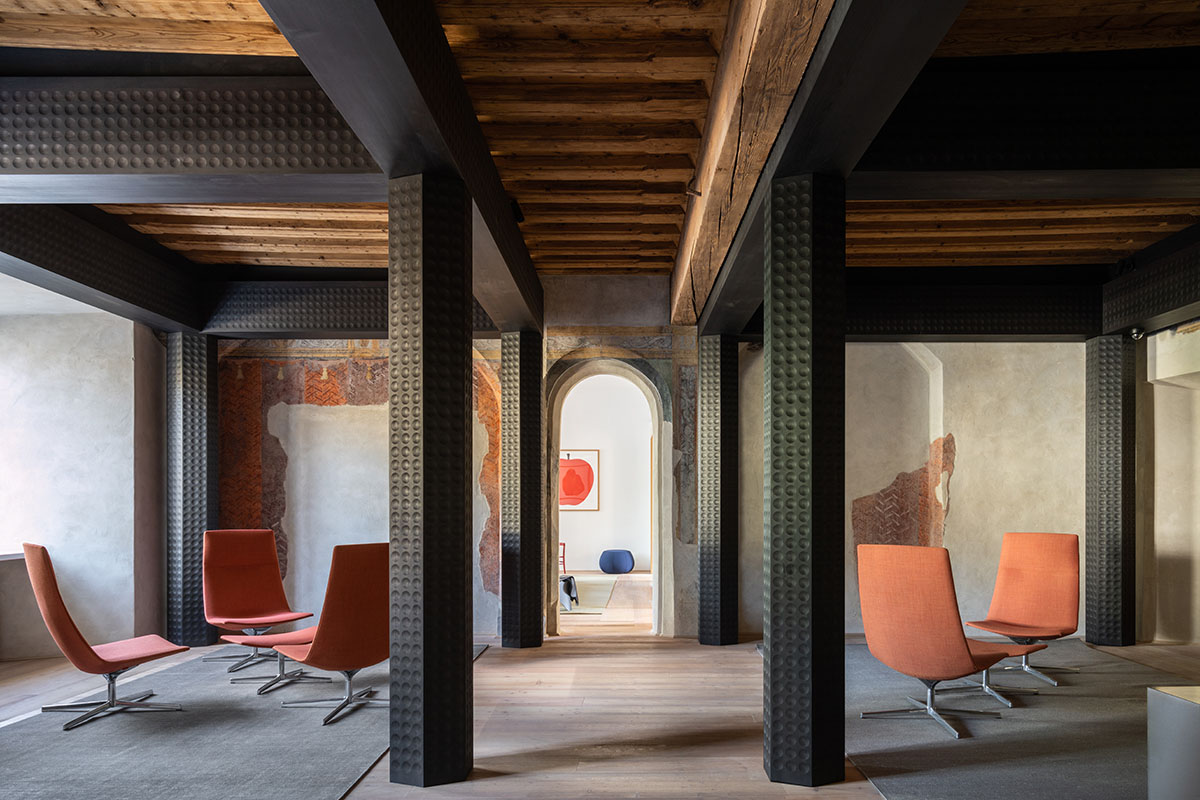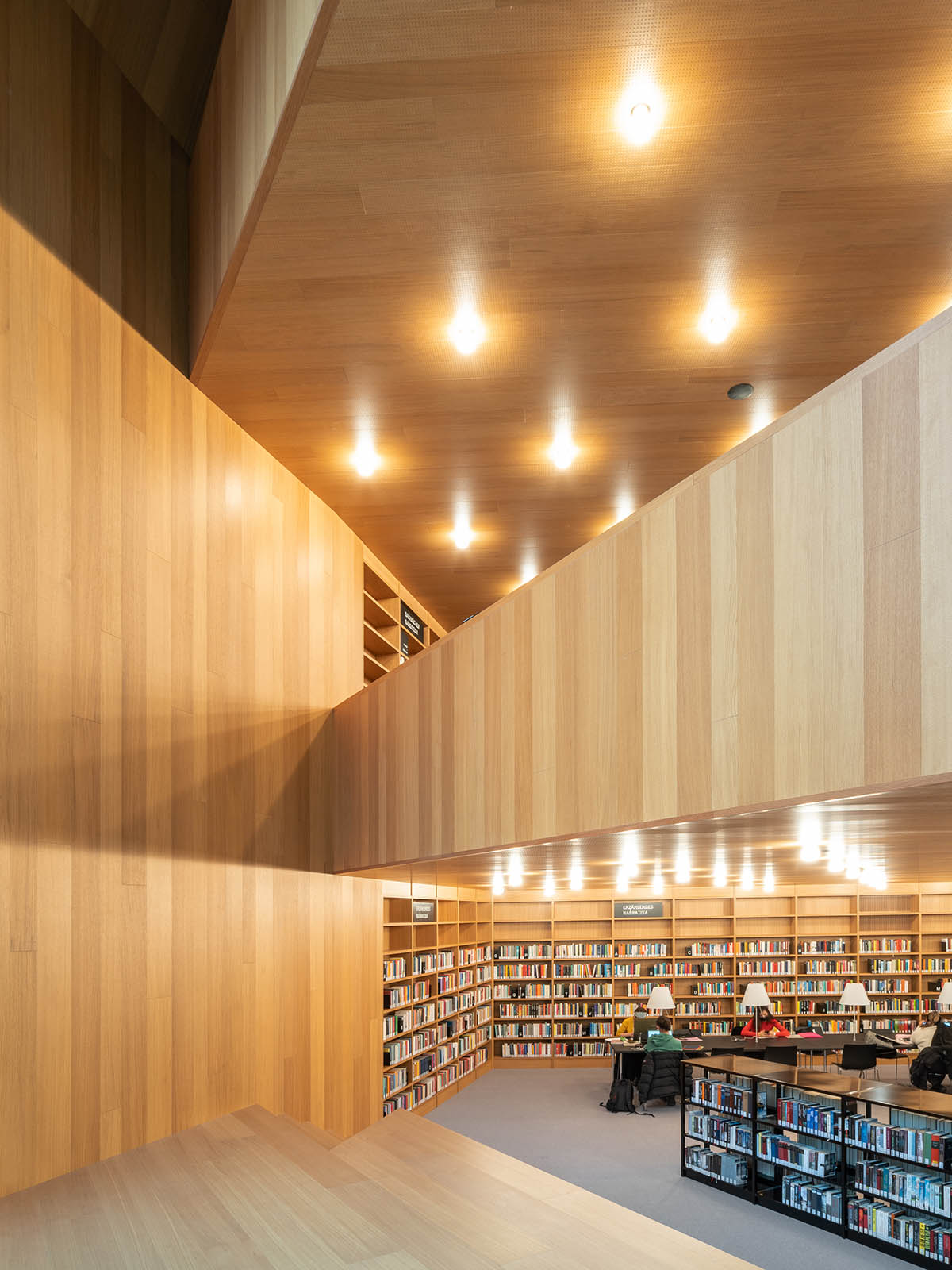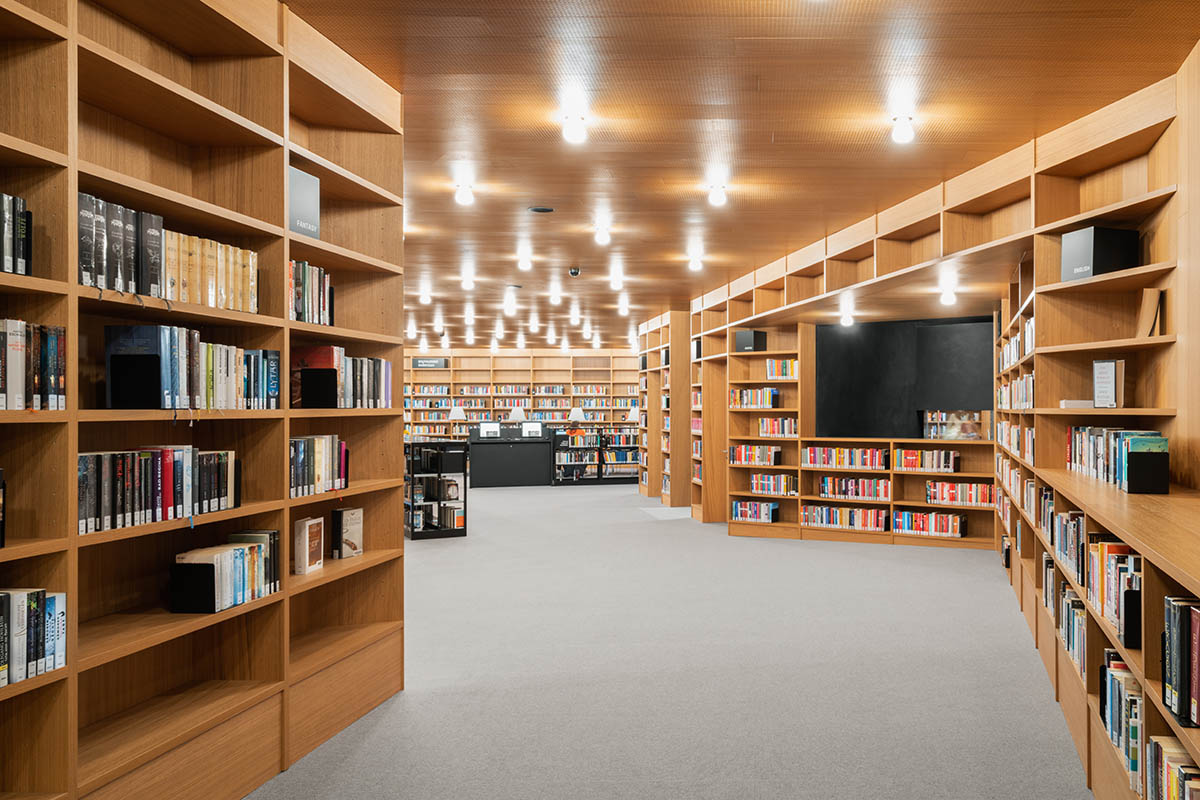Submitted by WA Contents
Brixen Public Library by Carlana Mezzalira Pentimalli acts like "a sensitive organism" in Italy
Italy Architecture News - Jan 03, 2023 - 12:51 3600 views

Italian architecture studio Carlana Mezzalira Pentimalli has designed a public library that acts like "a sensitive organism" that can continuously adapt itself to the needs of the site and the project in Bolzano, Italy.
Named Brixen Public Library, the 3,013-square-metre library has angular surfaces and protruding large windows that grasp the views from its surrounding.

Detail of the southern erker
The new Brixen Public Library by Carlana Mezzalira Pentimalli represents a stone's throw from the Duomo, a public institution founded in 1984, which, with its legacy of over 36.000 books represents a landmark for the entire Isarco Valley.
With the completion of this public library, the studio is providing the community a contemporary space for learning and sharing, a welcoming urban living room. While it reinforces local cultural identity, the library instills a strong sense of social cohesion, according to the studio.

The new project in the urban context of the historic center
"This is not a library intended as a large container of books – quite the opposite," said the architects Michel Carlana, Luca Mezzalira and Curzio Pentimalli.
"It is a project deeply rooted in its context, designed to welcome and generate human relationships and exchanges, intertwining cultures, practices and people of different ages," the architects added.

Detail of the west erker of the library. All floors of the new building face towards the Bishop's Palace and the Duomo, two of the most important buildings in the old town
The overhaul of a unitary complex includes a new building and the restorantion and annexation of the existing buildings of the Ex Finance, a portion of the Ex Court (the first two levels) and of the Ex Prison (part of the ground floor and first floor).
After a comprehensive site analysis, the studio devise a careful intervention plan with the redefinition of the existing external spaces, addition of two pedestrian access areas to the north and south of the Ex Finance building, and the garden adjacent to Via Bruno, which was once private and owned by the Bishop.

Close-up view of the secondary access from Via Bruno
While the new library building is situating itself silently and extremely respectfully into its surroundings, the intervention is located south of the Ex Court, in the void generated between two existing buildings, where, before the demolition, there was a lot belonging to the Diocese.
The new building creates a real connection with the existing buildings through its strong structural expression, which looks like a "tree" that leans its cement "branches" towards the buildings of the Ex Finance and the Ex Court.
According to the studio, it establishes a perpetual relationship between new and old, and inspires the architects to rename the project as "Kulturbaum, tree of culture".

The main entrance to the new public library is located in the north side of the Ex Finance, overlooking Piazza Duomo
The studio follows a special analogy on a planimetric level, dictated by the need for great flexibility and adaptability of the spaces of a contemporary public library.
"Far from adopting the classic shelving system, the building has a double perimeter shell located between the external concrete walls and the wooden paneling that covers the interiors, and which houses most of the serving spaces: from the vertical distribution to the toilets, to the furniture with bookcases, fixed benches, tables, and more," said the studio.
"This "cortex" envelops the space, completely freeing it from any functional obligation."

The quadruple height space of the foyer is obtained by incorporating the east façade of the Ex Finance and the south façade of the Ex Court within the new building
"The versatility of the environments has also guided the intended management and use of the library."
"By controlling some strategic access points, in fact, the complex can be completely or partially permeable to the different floors," the studio continued.
In this way, according to the architects, both the buildings and the related external appurtenances could serve as independent elements to be used autonomously, to perform multiple functions and events at different times.

The main foyer of the new library
The connections that are created between the new building and the existing buildings are conceived in a tangible way so that it can fulfill formal, functional and distributive needs.
The final mass of the new building is derived from deformations through contractions and dilations in order to recompose itself according to the surrounding stereometries. The project is far far from self-referencing and it has the potential of adapting itself to different and changing needs in the future.

The main foyer of the new library looking north, with the connection between the new building, the Ex Court and the Ex Finance
To resolve the minor differences in elevation between the three buildings, the studio uses the new "branches" that compensate for the changes in elevation through slight slopes.
The new volume has two vertical links with different characteristics. The closed fire escape, in addition to serving all floors of the courthouse as an emergency exit, also acts as a staircase that connects the ground floor with the attic of the new building.
The open staircase has been positioned barycentrically with respect to the functional masses that develop along the various levels.

The quadruple height atrium with the different views from the relative floors
It facilitates quick connections between the floors, inviting those who walk through it to enjoy glimpses of the new spatiality. Compositionally and functionally, both staircases are incorporated into the "cortex", while the pre-existing Ex Finance staricase is mainly intended for service use.
Total continuity is guaranteed between the exteriors, enhanced by the insertion of tailored furnishing elements, and the interiors of the new library, intended to perform as a true public space. Entering the new building is like stepping into a portion of the city center.

Side view of the main staircase of the new building, finished with a reflective dark gray marble, to emphasize the different settings and atmospheres of the library
Access to the new building is provided from the ground floor through the infotheque. From here, a generous quadruple height space, occupied by the reception area, grants access to the lifts.
To the south, there is a newspaper library that can be made independent, ensuring excellent flexibility. On the first floor, the fiction area is designed as an open space which provides access — through a second reception area — to the activities located in the Ex Court and Ex Finance or to the upper floors via a staircase and lift. The second floor is mainly occupied by the non-fiction / treatise area, which directly connects to the Ex Finance building, extending this function.

The triple-height space of the east erker, a true domestic living room for the library
On the third floor, an additional reception area acts as a junction between the multipurpose room and the literary events area. Toilets, cleaning rooms, storage areas and information desks are evenly distributed on the various levels.
The renovation of the other existing buildings has enhanced their ancient character and their high degree of flexibility to accommodate different activities open to the public.

The frescoes room on the first floor of the Ex Court. The relaxation area, with the children's area in the background, is characterized by an ancient fresco, emphasized by an original wooden canopy structure
The Ex Finance building is configured as an access point to the new intervention with the main front facing Piazza Duomo. On the ground floor, in addition to the two access points to the north (main) and south (secondary), there is an infotheque, a borrow and return area, and cloakroom spaces.
The first floor houses the internal offices of the library, while the second and third floors host spaces for non-fiction and treatises and a multipurpose room. Accessibility is granted through a designated independent stairwell and lift.

Close-up view of the west erker, on the second floor
The ground floor of the Ex Court building mainly houses service areas: automated warehouses, the area for checking the 24 h borrow and return area, an external counter, toilets and technical rooms.
The first floor ecompasses the children's area, the kids' area, music department with archive, playroom and a multipurpose room.

The children's area on the first floor of the Ex Court
The entrance is located on the first floor from the south of the building, the children's area is situated on the east side of the corridor, while the playroom is on the west.
Continuing along the corridor, before the frescoes room, the multipurpose room is located to the east and the music archive to the west.
To the north, the children's area is housed in a more secluded setting, with two independent rooms and a large area that can also be divided with furniture containing books and games.

The children's area on the first floor of the Ex Court
In the Ex Prison building, a passage gallery and an adjacent ancillary room have been built.
Special attention has been paid to natural lighting, which is essential not only for reading, but also for the maintenance and conservation of books. The south wall of the building, devoid of interesting views, is deliberately blind to prevent the entry of direct light, and equipped on the inside with a "bookcase wall" that occupies the entire height of the building.
This continuous boiserie, which becomes the library's manifesto as a treasure chest of knowledge.

View of the main staircase with the west erker of the second floor in the background
The main components of the context have been reinterpreted in a contemporary key, such as the characteristic “erker”– typical bow windows that characterize the historic center.
Two of these, of a giant order, favor strategic views: the building overlooks the two main areas of Brixen, the White Tower and the bell tower of the Cathedral on one side, and the Bishop's Palace on the other, tracing a line of continuity with the city’s landmarks and most iconic elements.

The attic of the top floor of the new building is intended for multiple uses, to embrace the different cultural activities of the city
Formally, the two erkers on the outside represent the extension of the volume of the building, within which they recreate a spatiality typical of Nordic culture, forming alcoves ideal for reading or admiring the landscape.
The large windows, which trace the boundary between inside and outside, have been designed to favor indirect light at the points where there is the greatest flux and concentration of people.

The attic of the top floor of the new building is intended for multiple uses, to embrace the different cultural activities of the city
Finally, two large skylights placed at the top of the complex pitched roof allow the sun's rays to cross the entire height of the building and reach the ground floor, thanks to an articulated system of retraction of the different floors, which plays a fundamental role in the introspection system between them.
Each internal glimpse, in which everything has been custom designed, is different, due to the great geometric and volumetric complexity of the building, camouflaged on the outside with clean and essential lines that blend perfectly with the pre-existing structures.

The triple-height space of the east erker, a true domestic living room for the library
The project of the new Brixen Public Library project by Carlana Mezzalira Pentimalli intensifies the close relationship between architecture and context.
Its formal outcome is a public venue, inspired by the architectural characteristics of Brixen, where the new feeds the old and vice versa, restoring exceptional architecture capable of interweaving historical and contemporary fabric.

The triple-height space of the east erker, a true domestic living room for the library

View from the third floor of the west erker, towards the Bishop's Palace

View of the "branch" connecting the first floor with the characteristic "cortex" of books

Side view of the reading space on the second floor of the east erker

Internal view between the new building and the Ex Finance building

The quadruple height atrium seen from the third floor of the new building, with the existing façades incorporated into the foyer of the new extension

Close-up view of the new furnishings and new lighting of the Ex Court

The relax area on the top floor of the Ex Finance

Side view of the top floor of the Ex Finance, looking towards the “branch” of the new building

Internal view of the third floor of the new building and of the “branch” connecting with the Ex Finance

Interior view of the third floor of the new building, looking towards the multipurpose room

The secondary staircase of the new building

The fiction area on the first floor

Side view of the secondary south entrance, from Via Bruno

Night view from the reading garden, with the east erker in dialog with the pre-existing structures

Site plan

Ground floor plan

First floor plan

Second floor plan

Third floor plan

Section

Section

Section

East elevation

West elevation

Model

Model
Carlana Mezzalira Pentimalli previously completed a music school made of deep cutouts and red-pigmented volumes in Bolzano, oldest city in Tyrol, the economic centre of the Isarco Valley and the third largest city in South Tyrol, Italy.
Carlana Mezzalira Pentimalli was founded by Michel Carlana, Luca Mezzalira, and Curzio Pentimalli in 2010 in Treviso, Italy. The studio strives to make urban planning and architecture a simple and lasting thing: organic, precise and necessary.
Project facts
Project name: Brixen Public Library
Architects: Carlana Mezzalira Pentimali (Michel Carlana, Luca Mezzalira, Curzio Pentimalli)
Project Team: Michel Carlana, Luca Mezzalira, Curzio Pentimalli, Marco Carraro, Alessio Oliviero
Location: Piazza Duomo 4, 39042 Brixen (BZ, Italy)
Size:
3.013 sqm (gross area of project)
2.378 sqm (gross area of the lot)
Client: Comune di Bressanone (BZ)
Design Phase: 2017-2018
Construction Phase: 2019-2021
Completion: 2022
Contractor: Unionbau
General Project Direction: Carlana Mezzalira Pentimalli, 3M Engineering
Project and Management of structures, Systems and Security coordination: Begmeister
Electric System, Safety, Lighting: Leitner Electro
Hydro-Thermal-Sanitary and Mechanical System: Ranzato Impianti
Lighting Consultant: Von Lutz Associates
Acoustic Consultant: NiRa Consulting (project phase)
External doors and windows: Askeen
Top image: View of the reading garden: once the Bishop's private garden, today it becomes a public place returned to the community of Brixen.
All images © Marco Cappeletti.
All drawings © Carlana Mezzalira Pentimalli.
